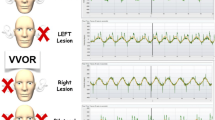Abstract
Vergence abnormalities could lead to inappropriate vestibulo-ocular reflex (VOR), causing vertigo and imbalance (Brandt 1999). Indeed, a recent study by Anoh-Tanon et al. (2000) reported the existence of a population of children with symptoms of vertigo in the absence of vestibular dysfunction but with abnormal vergence findings in orthoptic tests. The purpose of this study was to examine in such children the accuracy, duration and mean velocity of vergence and saccades; additionally, for a few subjects, the effect of orthoptic vergence training on these parameters was also investigated. LEDs were used to stimulate saccades, pure vergence along the median plane and combined saccade-vergence movements. Movements from both eyes were recorded with a photoelectric device (Bouis). The results show that children with vertigo perform saccades as normal subjects of comparable age. In contrast, vergence, particularly convergence, shows abnormalities: poor accuracy, long duration and low speed. During combined movements, the well known reciprocal interaction between the saccade and the vergence is present only for saccades combined with divergence; for saccades combined with convergence such interaction is abnormal: the saccade is slowed down by the convergence but the convergence is not accelerated by the saccade. Orthoptic training improves significantly the accuracy of all eye movements; such improvement was significant for all types of eye movements except for divergence (pure and combined). Furthermore, convergence remains abnormal and the lack of acceleration by the saccade persists. These specific convergence deficits could be of both subcortical and cortical origin. Orthoptic training improves the accuracy presumably via visual attentional mechanisms, but cannot completely override deficits related to subcortical deficiencies.





Similar content being viewed by others
References
Anoh-Tanon MJ, Brémond-Gignac D, Wiener-Vacher S (2000) Vertigo is an underestimated symptom of ocular disorders: dizzy children do not always need MRI. Pediatr Neurol 23:49–53
Bach M, Bouis D, Fischer B (1983) An accurate and linear infrared oculometer. J Neurosci Methods 9:9–14
Brandt T (1999) Vertigo. Its multisensory syndromes. Springer, Berlin Heidelberg New York
Bucci MP, Kapoula Z, Yang Q, Wiener-Vacher S, Brémond-Gignac D (2004) Abnormality of vergence latency in children with vertigo. J Neurol 251:204–213
Chaturvedi V, van Gisbergen JAM (2000) Stimulation in the rostral pole of monkey superior colliculus: effects on vergence eye movements. Exp Brain Res 132:72–78
Coenen O (1998) Modeling the vestibulo-ocular reflex and the cerebellum: analytical and computational approaches. In: PhD dissertation. University of California, San Diego, CA
Collewijn H, Erkelens CJ, Steinman RM (1988) Binocular co-ordination of human horizontal saccadic eye movements. J Physiol 404:157–182
Collewijn H, Erkelens CJ, Steinman RM (1995) Voluntary binocular gaze-shifts in the plane of regard: dynamics of version and vergence. Vision Res 35:3335–3358
Fioravanti F, Inchingolo P, Pensiero S, Spanio M (1995) Saccadic eye movement conjugation in children. Vision Res 35:3217–3228
Fischer B, Hartnegg K (2000) Effects of visual training on saccade control in dyslexia. Perception 29:531–542
Fischer B, Biscaldi M, Gezeck S (1997) On the development of voluntary and reflexive components in human saccade generation. Brain Res 754:285–297
Fukushima J, Hatta T, Fukushima K (2000) Development of voluntary control of saccadic eye movements I. Age-related changes in normal children. Brain Dev 22:173–180
Gamlin PD (2002) Neural mechanisms for the control of vergence eye movements. Ann N Y Acad Sci 956:264–272
Gamlin PD, Yoon K (2000) An area for vergence eye movement in primate frontal cortex. Nature 407:1003–1007
Kapoula Z, Robinson DA (1986) Saccadic undershoot is not inevitable: saccades can be accurate. Vision Res 26:735–743
Kapoula Z, Isotalo E, Muri RM, Bucci MP, Rivaud-Pechoux S (2001) Effects of transcranial magnetic stimulation of the posterior parietal cortex on saccades and vergence. Neuroreport 12:4041–4046
Klein C, Foerster F (2001) Development of prosaccade and antisaccade task performance in participants aged 6 to 26 years. Psychophysiology 38:179–189
Leigh RJ, Zee DS (1999) The neurology of eye movement. Oxford University Press, New York
Mays LE (1984) Neural control of vergence eye movements: convergence and divergence neurons in midbrain. J Neurophysiol 51:1091–1108
Mays LE, Porter JD, Gamlin PD, Tello CA (1996) Neural control of vergence eye movements: neurons encoding vergence velocity. J Neurophysiol 56:1007–1021
Munoz DP, Broughton JR, Goldring JE, Armstrong IT (1998) Age-related performance of human subjects on saccadic eye movement tasks. Exp Brain Res 121:391–400
Riddell PM, Fowler MS, Stein JF (1990) Spatial discrimination in children with poor vergence control. Percept Mot Skills 70:707–718
Snyder LH, Lawrence DM, King WM (1992) Changes in the vestibulo-ocular reflex (VOR) anticipate changes in vergence angle in monkey. Vision Res 32:569–575
Takagi M, Frohman EM, Zee DS (1995) Gap-overlap effects on latencies of saccades, vergence and combined vergence-saccades in humans. Vision Res 35:3373–3388
van Leeuwen AF, Westen MJ, van der Steen J, de Faber JT, Collewijn H (1999) Gaze-shift dynamics in subjects with and without symptoms of convergence insufficiency: influence of monocular preference and the effect of training. Vision Res 39:3095–3107
von Noorden GK (2002) Binocular vision and ocular motility. Theory and management of strabismus. Mosby, St. Louis
Wiener-Vacher S, Toupet F, Narcy P (1996) Canal and otolith vestibulo-ocular reflexes to vertical and off vertical rotations in children learning to walk. Acta Otolaryngol Stockh 116:657–665
Yang Q, Kapoula Z (2004) Saccade-vergence dynamics and interaction in children and in adults. Exp Brain Res (in press)
Yang Q, Bucci MP, Kapoula Z (2002) The latency of saccades, vergence, and combined eye movements in children and in adults. Invest Ophthalmol Vis Sci 43:2939–2949
Zee DS, Fitzgibbon EJ, Optican LM (1992) Saccade-vergence interactions in humans. J Neurophysiol 68:1624–1641
Acknowledgements.
This study was supported by INSERM (contract no. 4M105E) and by Disfonctionnement Cognitif (MRT Cognitique). Dr. M.P. Bucci was supported by EDF and FRM; Dr. Q. Yang was supported by CNRS-K.C. WONG.
Author information
Authors and Affiliations
Corresponding author
Rights and permissions
About this article
Cite this article
Bucci, M.P., Kapoula, Z., Yang, Q. et al. Speed-accuracy of saccades, vergence and combined eye movements in children with vertigo. Exp Brain Res 157, 286–295 (2004). https://doi.org/10.1007/s00221-004-1842-0
Received:
Accepted:
Published:
Issue Date:
DOI: https://doi.org/10.1007/s00221-004-1842-0




